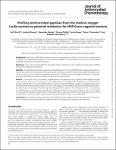Profiling antimicrobial peptides from the medical maggot Lucilia sericata as potential antibiotics for MDR Gram-negative bacteria
Hirsch, Rolf
Wiesner, Jochen
Marker, Alexander
Pfeifer, Yvonne
Bauer, Armin
Hammann, Peter E.
Vilcinskas, Andreas
Background
The ability of MDR Gram-negative bacteria to evade even antibiotics of last resort is a severe global challenge. The development pipeline for conventional antibiotics cannot address this issue, but antimicrobial peptides (AMPs) offer an alternative solution.
Objectives
Two insect-derived AMPs (LS-sarcotoxin and LS-stomoxyn) were profiled to assess their suitability for systemic application in humans.
Methods
The peptides were tested against an extended panel of 114 clinical MDR Gram-negative bacterial isolates followed by time–kill analysis, interaction studies and assays to determine the likelihood of emerging resistance. In further in vitro studies we addressed cytotoxicity, cardiotoxicity and off-target interactions. In addition, an in vivo tolerability and pharmacokinetic study in mice was performed.
Results
LS-sarcotoxin and LS-stomoxyn showed potent and selective activity against Gram-negative bacteria and no cross-resistance with carbapenems, fluoroquinolones or aminoglycosides. Peptide concentrations of 4 or 8 mg/L inhibited 90% of the clinical MDR isolates of Escherichia coli, Enterobacter cloacae, Acinetobacter baumannii and Salmonella enterica isolates tested. The ‘all-d’ homologues of the peptides displayed markedly reduced activity, indicating a chiral target. Pharmacological profiling revealed a good in vitro therapeutic index, no cytotoxicity or cardiotoxicity, an inconspicuous broad-panel off-target profile, and no acute toxicity in mice at 10 mg/kg. In mouse pharmacokinetic experiments LS-sarcotoxin and LS-stomoxyn plasma levels above the lower limit of quantification (1 and 0.25 mg/mL, respectively) were detected after 5 and 15 min, respectively.
Conclusions
LS-sarcotoxin and LS-stomoxyn are suitable as lead candidates for the development of novel antibiotics; however, their pharmacokinetic properties need to be improved for systemic administration.
Dateien zu dieser Publikation

